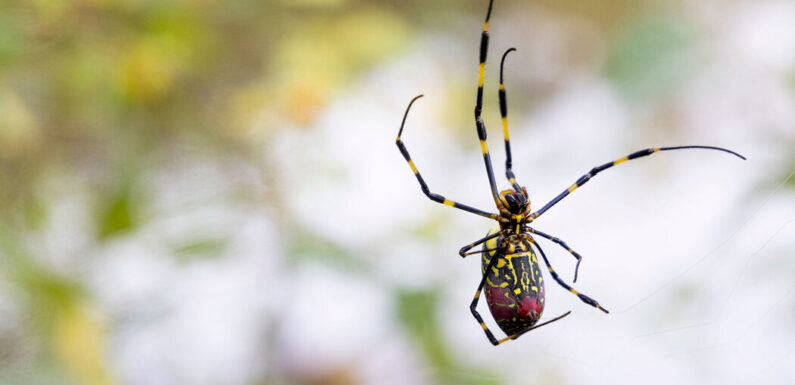
Joro spiders are the size of your palm. They weave webs up to three feet across, and for the past decade, the East Asian arachnids have been spreading throughout the southeastern United States.
“If you’re an arachnophobe, they’re the stuff of your nightmares,” said Andy Davis, a biologist at the University of Georgia who studies them.
But, Dr. Davis said, joros are “gentle giants” that are prone to shyness and are more inclined to freeze than to fight. The results of his latest experiments, published this week in the journal Arthropoda, show that the spiders remain stock-still for over an hour when puffed with air from a turkey baster. By comparison, smaller spiders appeared relatively unfazed, indicating that even big, scary spiders can be scaredy-cats.
Joros were first spotted in northeastern Georgia in 2013; Dr. Davis’s best guess is that the spiders’ eggs arrived in shipping containers, because they tended to show up around highways. He first spotted a Joro spider while walking with his wife around his university’s campus; he remembers stopping to take a picture because “it was so striking.” He has been studying the spiders ever since.
Joros have been the subject of media attention as they’ve spread; Dr. Davis suspects that they’ll reach New York this summer. But unlike another invasive bug, the tree-destroying spotted lantern flies, which have a death warrant in the Big Apple, there’s no evidence of whether joros are affecting the North American continent for better or worse. (At the very least, their venom is too weak to hurt humans.)
Despite the lack of data on their behavior, Dr. Davis said, joros get a bad rap, because some people equate the spiders’ spread around the South with boldness.
“People think that the joros are aggressively outcompeting native spiders,” he said. The study’s aim, he added, is to assess “how aggressive are these joros?”
Dr. Davis and Amitesh Anerao, who recently completed his undergraduate studies at Georgia, set about examining the spiders’ boldness with a tried-and-true lab test: puffing the joros with air from a turkey baster, and then measuring how long it took for them to resume movement. The experiment is based on the idea that cornered spiders may freeze in a last-ditch attempt to avoid getting snatched by a hungry bird. The puff of air attempts to simulate the beating of the bird’s wings.
When the researchers puffed air at small garden spiders and orb weavers and culled data from previous research on five other species, they found that it took an average of a minute and a half for the smaller spiders to resume movement.
The joros were another story.
“At first, I tried to do these in the lab, but I mean, some of the joros were just freezing for over two hours at a time. At that point, the building was closing, I had to leave,” Mr. Anerao said. So he took the spiders home to his apartment, where he could let the spiders take their time.
The joros in the study averaged more than an hour of stillness after being puffed. The same was true of golden orb weavers, a cousin of the joro and native to the Americas. The researchers say that this behavior points to their genus, Trichonephila, as being among the shyest spiders ever documented.
Angela Chuang, a postdoctoral researcher at the University of Florida who was not involved with the study, notes that aggression, in terms of fighting with other creatures, is different from boldness or a lack of shyness.
They urged caution in extrapolating the spiders’ overall behavior in the wild from their reactions in this study.
“I would be very cautious about just calling them shy spiders — like, yeah, in what context?” Dr. Chuang said. “Apparently, it’s shy in the context of getting puffed with air, which tells us nothing about their actual interactions with any other species.”
Dr. Davis and Dr. Chuang agree that more experiments and observations are needed to understand how joros are interacting with their new home. The results of another set of unpublished experiments offer a preliminary hint. Mr. Anerao put joro spiders in a container with native spiders “and had them duke it out to see who would win, and the joros always lost,” Dr. Davis said. “They were always the first to flee.”
If you spot a joro, rather than running away or squishing it, Dr. Chuang proposed taking a picture and uploading it to a website like iNaturalist to aid researchers in tracking the arachnids.
“Our research has been helped a lot by public awareness,” they said.
Source: Read Full Article